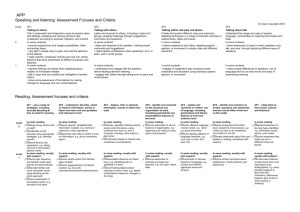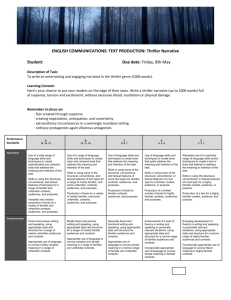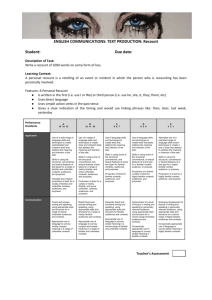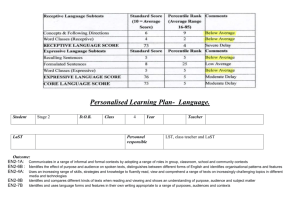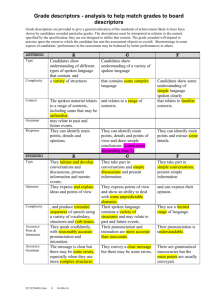Student 2 response (A
advertisement
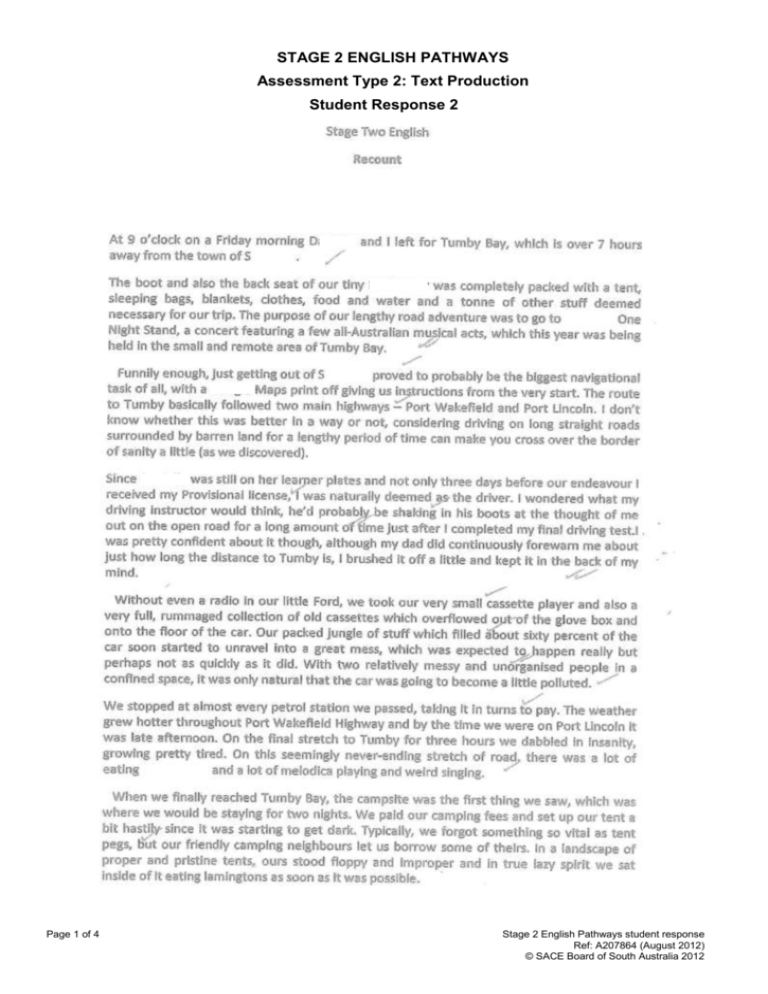
STAGE 2 ENGLISH PATHWAYS Assessment Type 2: Text Production Student Response 2 Page 1 of 4 Stage 2 English Pathways student response Ref: A207864 (August 2012) © SACE Board of South Australia 2012 Additional Comments: This example is illustrative of an A- grade. This recount is a sophisticated piece of writing which demonstrates a comprehensive knowledge and understanding of the conventions of the form. It shows sophisticated skills in reproducing the textual features of the recount. The reader is oriented quickly to the event in the opening sentence. A strong personal voice is heard from the first person narrator as the writer orients us to the past event with specific details of the trip. The voice is lively and humorously self-deprecating at times. There is an engaging use of slang ‘went mental for them’ and ‘tonne of stuff’ juxtaposed with more formal expressions like ‘a concert featuring a few all Australian acts’. The text is cohesive and well-structured with a strong focus on the events of the trip – use of cohesive and transitional words aid – ‘before’, ‘after’ and ‘when we finally reached’. The conclusion is reflective although it could have had a stronger focus on the meaning of the trip to the writer. There is use of a range of sentence structures to vary the pace and gain and maintain reader interest. Compound and complex sentences are mainly well constructed and varied ‘Funnily enough, just getting out of …’ and ‘With two relatively messy and ….’ Different sentence beginnings add interest ‘Being fuelled by caffeine…’ There is a sound range of descriptive words and images which show a skillful use of a variety of techniques such as metaphor and alliteration ‘In a landscape of proper and pristine tents’, ‘packed jungle of stuff’ and ‘dabbled in insanity’. There is also the use of a pun – ‘cross over the border of sanity.’ Complex noun groups evident and well controlled ‘a very full, rummaged collection of old cassettes’, ‘this seemingly never-ending stretch of road’, ‘.. our friendly camping neighbours’ and, ‘the biggest navigational task of all’. There is also a range of verbs used ‘was deemed’, ‘dabbled’, ‘bided’ and ‘started to unravel’. There is repetition of the concept of the length of the trip ‘our lengthy road adventure’, ‘driving on long straight roads’, ‘just how long the distance to Tumby is’, ‘the final stretch to Tumby’, which is finally contrasted to ‘the trip back …. seemed effortless in comparison to our journey there.’ Accuracy, clarity and fluency are evident throughout the entire piece. Page 2 of 4 Stage 2 English Pathways student response Ref: A207864 (August 2012) © SACE Board of South Australia 2012 Performance Standards for Stage 2 English Pathways A Knowledge and Understanding Analysis Application Communication Detailed knowledge and understanding of the ideas, values, and beliefs in familiar and unfamiliar texts. Detailed analysis of complex connections between personal experiences, ideas, values, and beliefs, and those explored in familiar and unfamiliar texts. Use of a comprehensive range of language skills to interact effectively in different contexts, and to analyse and solve simple and complex problems. Fluent and precise writing and speaking, using an appropriate style and structure for a range of mainly unfamiliar audiences and contexts. Perceptive analysis of a range of ways in which authors use language techniques to influence opinions and decisions in familiar and unfamiliar texts. Location, recording, analysis, and synthesis of knowledge relevant to familiar and unfamiliar contexts. Appropriate use of language to convey mostly complex meaning in a range of familiar and unfamiliar contexts. Knowledge and understanding of the ways in which the creators and readers of familiar and unfamiliar texts use a range of language techniques to make meaning. B Comprehensive knowledge and understanding of the ways in which familiar and unfamiliar texts are composed for a range of purposes and audiences. Perceptive analysis of aspects of familiar and unfamiliar cultural, social, and technical roles of language that support effective interactions in different contexts. Sound knowledge and understanding of some ideas, values, and beliefs in familiar, and some unfamiliar, texts. Analysis of some complex connections between personal experiences, ideas, values, and beliefs, and those explored in familiar, and some unfamiliar, texts. Knowledge and understanding of the ways in which the creators and readers of mainly familiar texts use some language techniques to make meaning. Sound knowledge and understanding of the ways in which mainly familiar texts are composed for some purposes and audiences. C Knowledge and understanding of some ideas, values, or beliefs in familiar texts. Knowledge and understanding of the ways in which the creators and readers of a narrow range of familiar texts use some language techniques to make meaning. Knowledge and understanding of the ways in which familiar texts are composed for familiar purposes and audiences. Page 3 of 4 Well-considered analysis of a range of ways in which authors use language techniques to influence opinions and decisions in familiar, and some unfamiliar, texts. Well-considered analysis of aspects of mainly familiar, and some unfamiliar, cultural, social, or technical roles of language that support effective interactions in different contexts. Sophisticated skills in reproducing the structural, conventional, and textual features of text types for a range of familiar and unfamiliar contexts, audiences, and purposes. Use of a sound range of language skills to interact effectively in different contexts, and to solve simple and complex problems. Mostly fluent and precise writing and speaking, using an appropriate style and structure for a range of mostly familiar audiences and contexts. Location, recording, analysis, and occasional synthesis of knowledge relevant to mostly familiar contexts. Appropriate use of language to convey complex and simple meaning in a range of familiar, and some unfamiliar, contexts. Sound skills in reproducing some of the structural, conventional, and textual features of text types for a range of mainly familiar, and some unfamiliar, contexts, audiences, and purposes. Competent analysis of simple connections between personal experiences, ideas, values, or beliefs, and those explored in familiar texts. Use of competent language skills to interact effectively in different contexts, and to solve routine problems in familiar contexts. Descriptive analysis of a number of ways in which authors use language techniques to influence opinions and decisions in familiar texts. Location, recording, and occasional analysis of knowledge relevant to a familiar context. Competent analysis of some aspects of mainly familiar cultural, social, or technical roles of language that support effective interactions in different contexts. Generally clear and accurate writing and speaking, using an appropriate style and structure for familiar audiences and contexts. Appropriate use of language to convey simple meaning in a narrow range of familiar and unfamiliar contexts. Skills in reproducing some of the structural, conventional, and textual features of some text types for familiar contexts, audiences, and purposes. Stage 2 English Pathways student response Ref: A207864 (August 2012) © SACE Board of South Australia 2012 D Knowledge and Understanding Analysis Application Communication Identification of some simple ideas, values, or beliefs in some familiar texts. Reference to simple connections between uncomplicated personal experiences, ideas, values, or beliefs, and those explored in familiar texts. Use of a restricted range of language skills to interact in familiar contexts, and to solve simple problems. A level of fluency in writing and speaking in personally relevant situations, using an appropriate style and structure for a narrow range of familiar audiences and contexts. Knowledge and understanding of the ways in which the creators and readers of a narrow range of familiar texts use a restricted range of language techniques to make simple or factual meaning. E Reference to some ways in which authors use language techniques to influence opinions and decisions in familiar texts. Knowledge of the ways in which familiar texts are composed for personally relevant purposes and familiar audiences. Reference to some simple aspects of familiar cultural, social, or technical roles of language that support effective interactions in one or more contexts. Identification of a simple idea, value, or belief in a familiar text. Recognition of a simple connection between a straightforward personal experience, idea, value, or belief, and that explored in a highly familiar text. Some knowledge and emerging understanding of the way in which a creator or reader of a highly familiar text uses a language technique to make factual meaning. Some knowledge of the ways in which highly familiar texts are composed for personally relevant purposes and highly familiar audiences. Page 4 of 4 Reference to the way in which an author uses language techniques to influence opinions and decisions in a highly familiar text. Recognition of some simple aspects of highly familiar cultural, social, or technical roles of language that support effective interactions in one or more contexts. Location and recording of factual knowledge relevant to a familiar context. Limited skills in reproducing some of the structural, conventional, or textual features of a text type for a familiar context, audience, or purpose. Use of a restricted range of language skills to interact in highly familiar contexts, and to solve simple problems. Location or recording of factual knowledge relevant to a highly familiar context. Restricted skills in reproducing a limited number of structural, conventional, or textual features of a text type for a highly familiar context, audience, or purpose. Occasionally appropriate use of language to convey simple meaning in familiar contexts. Emerging development of fluency in writing and speaking in personally relevant situations, using an appropriate style and structure for a narrow range of highly familiar audiences and contexts. Occasionally appropriate use of language to convey literal meaning in highly familiar contexts. Stage 2 English Pathways student response Ref: A207864 (August 2012) © SACE Board of South Australia 2012

